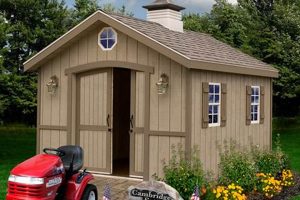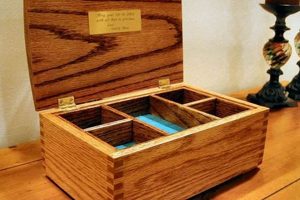The creation of handmade items from timber represents a popular and diverse segment of the crafting world. Examples include constructing small decorative boxes, building birdhouses, fashioning personalized signs, and assembling furniture pieces from readily available lumber. These projects cater to a wide range of skill levels, from beginner to experienced woodworkers.
Engaging in the practice of producing wooden objects provides numerous advantages. It fosters creativity, allows for personalization and customization of home decor, and promotes sustainable practices through repurposing and upcycling. Furthermore, this activity offers a tangible and rewarding experience, often resulting in unique and cherished possessions. Historically, woodworking has been a fundamental skill across cultures, providing essential tools and shelter, evolving over time into artistic expression and hobbyist pursuits.
The subsequent sections will delve into specific project ideas, essential tools and techniques, safety considerations, and finishing methods applicable to a variety of woodworking endeavors, ensuring successful and enjoyable project outcomes.
Guidance for Timber-Based Creative Projects
The following guidelines are designed to enhance the execution and outcome of self-directed timber construction projects, promoting both quality and safety.
Tip 1: Material Selection is Crucial. The type of wood impacts both aesthetics and structural integrity. Softwoods like pine are easier to work with for beginners, while hardwoods such as oak offer greater durability and visual appeal for advanced projects. Assess the project’s requirements to determine the appropriate wood species.
Tip 2: Precise Measurement and Marking are Essential. Inaccurate dimensions lead to structural instability and aesthetic flaws. Utilize a high-quality measuring tape, a precision square, and a sharp marking tool. Double-check all measurements before commencing cutting or assembly.
Tip 3: Employ Proper Safety Equipment. Woodworking inherently involves potential hazards. Always wear safety glasses to protect against flying debris, and use appropriate respiratory protection when sanding or applying finishes. Ear protection is recommended when operating power tools.
Tip 4: Secure Workholding is Paramount. Clamps and vises are critical for stabilizing workpieces during cutting, drilling, and assembly. Inadequate workholding can result in inaccurate cuts, damage to the workpiece, or personal injury. Employ appropriate clamping techniques for each operation.
Tip 5: Pre-Drilling Prevents Splitting. When driving screws or nails into wood, pre-drilling pilot holes is often necessary to prevent the wood from splitting, particularly near edges. Select a drill bit size slightly smaller than the fastener’s shank diameter.
Tip 6: Sanding is Key to a Smooth Finish. Thorough sanding is vital for achieving a professional-looking finish. Begin with coarser grits to remove imperfections, then gradually progress to finer grits for a polished surface. Sand with the grain to avoid unsightly scratches.
Tip 7: Apply Finishes in a Well-Ventilated Area. Wood finishes often contain volatile organic compounds (VOCs) that can be harmful if inhaled. Ensure adequate ventilation when applying paints, stains, varnishes, or sealants. Consider using low-VOC or water-based alternatives.
Tip 8: Consider Joinery Methods Carefully. The chosen joinery method significantly influences the strength and appearance of the finished piece. Explore various options, such as dovetails, mortise and tenon joints, or pocket screws, and select the most appropriate method for the project’s requirements and the builder’s skill level.
By adhering to these guidelines, individuals engaging in handcrafted timber projects can enhance their skills, improve the quality of their work, and minimize potential risks. A meticulous approach to each stage of the process is crucial for achieving satisfactory and enduring results.
The concluding segment will explore project examples of varying difficulty, providing inspiration and practical guidance for further exploration of timber-based creations.
1. Wood Selection
The selection of appropriate wood species is paramount to the success of any handcrafted timber project. Wood’s characteristics directly influence the structural integrity, aesthetic appeal, workability, and ultimately, the longevity of the final product. Careful consideration must be given to the specific requirements of the intended project.
- Wood Hardness and Durability
The hardness of wood significantly impacts its resistance to wear, denting, and scratching. Hardwoods, such as oak and maple, are suitable for high-traffic items like furniture and cutting boards due to their superior durability. Softwoods, like pine and fir, are more easily worked and are appropriate for decorative items or projects where weight is a concern. Projects designed for outdoor use necessitate naturally durable woods like cedar or redwood, or require treatment with preservatives to resist rot and insect infestation.
- Grain Pattern and Aesthetics
Wood grain contributes significantly to the visual appeal of a finished piece. Different species exhibit distinctive grain patterns, ranging from the tight, uniform grain of maple to the bold, open grain of oak. Grain orientation also influences visual aesthetics; selecting quarter-sawn or rift-sawn lumber can highlight specific grain characteristics. The choice of wood grain should complement the intended style and finish of the woodworking craft.
- Workability and Tooling
The ease with which wood can be cut, shaped, and joined varies considerably between species. Softwoods generally require less force to cut and are more forgiving of beginner errors. Hardwoods may require specialized tooling and techniques to avoid tear-out or splintering. Projects involving intricate carvings or detailed joinery may benefit from the use of close-grained hardwoods like cherry or walnut, which hold fine details well.
- Cost and Availability
The cost and availability of different wood species can significantly influence project feasibility. Exotic hardwoods can be prohibitively expensive and may require sourcing from specialized suppliers. Locally sourced woods are often more affordable and sustainable. Consider the overall budget and logistical constraints when selecting wood for timber creation.
The intertwined considerations of hardness, grain, workability, and cost demonstrate the multifaceted nature of wood selection in craft projects. Informed choices lead to aesthetically pleasing, structurally sound, and economically viable creations, enhancing the overall experience and outcome.
2. Tools Acquisition
The acquisition of appropriate tools is a fundamental prerequisite for successful engagement in timber construction. The range and quality of tools directly influence the complexity, precision, and efficiency of crafting processes. Strategic tool selection is, therefore, a crucial factor in realizing project goals.
- Essential Hand Tools
Hand tools form the foundation of woodworking. A well-stocked toolkit typically includes items such as saws (hand saws, coping saws, back saws), chisels (various sizes and types), planes (block planes, smoothing planes), measuring tools (tape measure, combination square, marking gauge), and fastening tools (hammers, screwdrivers). Mastery of these tools is essential for precise material removal, shaping, and joinery. Their absence limits the scope and sophistication of achievable projects.
- Power Tools for Efficiency
Power tools significantly enhance efficiency and expand the range of possible tasks. A power saw (circular saw, jigsaw, band saw) enables rapid cutting of lumber, while a power sander (orbital sander, belt sander) facilitates efficient surface preparation. Drills and drivers expedite fastener installation. While power tools offer increased speed and power, proficiency in their safe and accurate operation is crucial. An inadequate selection of power tools can restrict project size and complexity.
- Specialty Tools and Jigs
Specialty tools and jigs cater to specific woodworking tasks. Examples include routers for shaping edges and creating decorative profiles, jointers and planers for creating flat and square surfaces, and dovetail jigs for producing precise dovetail joints. These tools enhance accuracy and repeatability, enabling the creation of more intricate and refined projects. A lack of specialized tools can limit design possibilities and the complexity of joinery techniques.
- Maintenance and Sharpening Equipment
Proper maintenance and sharpening are essential for preserving the performance and longevity of woodworking tools. Sharpening stones, honing guides, and sharpening jigs are critical for maintaining sharp cutting edges on chisels, planes, and saw blades. Regular cleaning and lubrication prevent rust and ensure smooth operation. Neglecting tool maintenance diminishes performance, increases the risk of accidents, and ultimately shortens the lifespan of the tools. Without proper upkeep, projects suffer from decreased precision and increased difficulty.
The selection of tools significantly influences project scope and attainable quality. Careful consideration of project requirements, skill level, and budget constraints is necessary to assemble a toolkit that enables efficient, safe, and successful timber creations.
3. Project Planning
Effective project planning serves as the cornerstone of any successful timber crafting endeavor. The absence of a well-defined plan often results in material waste, inefficient resource allocation, and a diminished likelihood of achieving the desired outcome. Within the realm of “diy crafts with wood,” project planning encompasses a meticulous sequence of steps, commencing with conceptualization and extending through material procurement, dimensional calculations, and assembly strategies. A detailed plan mitigates potential errors and ensures a smoother crafting process. For instance, constructing a simple bookcase necessitates outlining dimensions, determining board foot requirements, and selecting appropriate joinery methods before any physical work commences. Failure to plan adequately can lead to insufficient material, structural instability, or aesthetic inconsistencies.
Proper project planning also incorporates risk assessment and mitigation. Identifying potential safety hazards, such as kickback from power tools or the inhalation of dust particles, allows for the implementation of preventative measures. Furthermore, planning involves anticipating challenges related to wood movement, joinery complexities, and finishing techniques. For example, when crafting an outdoor bench, one must account for wood expansion and contraction due to weather fluctuations. Incorporating appropriate joinery techniques and selecting weather-resistant finishes become crucial planning considerations. Without such foresight, the finished piece may succumb to premature degradation. Therefore, project planning extends beyond mere dimensioning and encompasses a comprehensive evaluation of potential challenges and appropriate solutions.
In summation, project planning acts as the pivotal link between conception and realization within timber crafting. Its importance is underscored by its capacity to minimize waste, enhance safety, and ensure the structural and aesthetic integrity of the finished product. While spontaneity may hold appeal in some creative domains, the inherent precision and inherent constraints of timber necessitate a structured, methodical approach. Recognizing and implementing effective project planning strategies is paramount for achieving rewarding and enduring outcomes.
4. Joint Construction
Joint construction, the process of uniting separate pieces of wood to form a cohesive structure, is a fundamental element within the realm of timber-based creative projects. The method employed significantly influences the strength, stability, and aesthetic characteristics of the final product. Inadequate joinery invariably leads to structural failure, while proficient jointing enhances both durability and visual appeal. Simple projects, such as basic picture frames, may rely on butt joints reinforced with fasteners. Conversely, complex furniture pieces necessitate sophisticated joinery techniques like mortise and tenon, dovetail, or miter joints to withstand stress and maintain structural integrity. Therefore, joint construction directly dictates the practical lifespan and utility of crafted wooden objects.
The selection of a particular jointing method hinges on several factors: the intended use of the piece, the type of wood employed, and the skill level of the craftsperson. For instance, a bookshelf intended to bear substantial weight requires robust joints capable of distributing the load evenly. Softwoods, being more prone to splitting, may necessitate different jointing strategies compared to hardwoods. Beginner woodworkers typically commence with simpler joints, gradually progressing to more intricate techniques as their skills develop. Furthermore, the aesthetic considerations of joint construction are noteworthy; exposed dovetails, for example, can serve as a decorative element, while concealed joints offer a cleaner, more minimalist appearance. Understanding these nuances allows for informed decisions that optimize both functionality and visual harmony.
In conclusion, joint construction is an indispensable aspect of “diy crafts with wood.” Its proper application dictates the structural integrity, longevity, and aesthetic value of the finished piece. A thorough understanding of jointing principles and the careful selection of appropriate methods are, therefore, essential for achieving successful and enduring results in any timber-based creative pursuit. Overlooking this critical component invariably compromises the quality and utility of handcrafted wooden items.
5. Surface Treatment
Surface treatment constitutes an essential phase in timber-based creative projects, directly influencing the longevity, appearance, and functionality of the finished item. The application of appropriate surface treatments mitigates degradation caused by environmental factors, enhances the aesthetic appeal of the wood, and can impart specific functional properties. A poorly executed or absent surface treatment renders even the most meticulously crafted wooden item vulnerable to damage from moisture, sunlight, insects, or everyday wear and tear. For instance, untreated wooden furniture exposed to direct sunlight experiences fading and cracking, while unfinished cutting boards readily absorb bacteria, posing a hygiene risk. Therefore, surface treatment is not merely an aesthetic consideration but a critical determinant of the crafted object’s durability and suitability for its intended purpose.
Surface treatment options encompass a broad spectrum, ranging from penetrating oils and waxes to film-forming varnishes and paints. The selection of a particular treatment depends on several factors, including the type of wood, the intended use of the item, and the desired aesthetic outcome. Penetrating oils, such as linseed or tung oil, enhance the natural grain of the wood while providing minimal protection against moisture. Varnishes and lacquers create a durable, protective film that resists scratches and stains but may obscure the wood’s natural texture. Paints offer extensive color options and can provide superior UV protection, but they often require multiple coats and may conceal the wood grain entirely. The practical implications of this understanding are significant; a wooden toy intended for outdoor use would benefit from a durable, weatherproof paint, while a decorative bowl might be best enhanced with a natural oil that accentuates the wood’s inherent beauty. Each selection dictates the longevity and aesthetic appeal of the final wooden piece.
In summary, surface treatment is an indispensable element of timber crafting, directly affecting the durability, aesthetics, and functional properties of the crafted item. The informed selection and proper application of surface treatments safeguard against environmental damage, enhance visual appeal, and ensure the long-term usability of wooden creations. Despite the initial appeal of skipping this step for speed or cost savings, the long-term benefits of appropriate surface treatment far outweigh any perceived inconveniences, ultimately contributing to the creation of lasting and valuable timber objects.
6. Safety Practices
The intersection of safety practices and timber-based creative projects constitutes a critical nexus, where adherence to established protocols directly determines the physical well-being of the craftsperson and the overall success of the endeavor. Failure to observe appropriate safety measures introduces significant risks, ranging from minor injuries such as splinters and lacerations to severe incidents involving power tool accidents and exposure to harmful chemicals. The inherent nature of working with woodworking tools and materials necessitates a proactive and diligent approach to safety, rendering it an indispensable component of any successful timber-crafting project. As an example, inadequate dust collection during sanding operations can lead to respiratory problems over time, while the improper use of a table saw can result in serious bodily harm. Therefore, safety is not an optional addendum but an integral aspect that must be meticulously integrated into every phase of the project.
The implementation of effective safety practices encompasses several key areas, including the consistent use of personal protective equipment (PPE), the proper operation and maintenance of tools, and the establishment of a safe and organized workspace. PPE, such as safety glasses, hearing protection, and respirators, serves as the first line of defense against potential hazards. Tool-specific safety protocols, outlined in manufacturer manuals and reinforced through training, must be rigorously followed to prevent accidents. A clutter-free workspace, with adequate lighting and ventilation, minimizes tripping hazards and promotes focus, reducing the likelihood of errors that can lead to injury. For instance, failing to secure a workpiece properly can result in the tool slipping and causing harm, while neglecting to inspect power cords for damage increases the risk of electrical shock. Each of these elements contributes to a safer working environment and reduces the likelihood of adverse events.
In summary, safety practices are inextricably linked to timber creation, functioning as a foundational element that ensures the well-being of the craftsperson and the integrity of the final product. By prioritizing safety through the consistent use of PPE, adherence to tool-specific protocols, and the maintenance of a safe workspace, individuals engaging in timber construction can mitigate risks and foster a sustainable and enjoyable crafting experience. While the allure of immediate project gratification may tempt some to overlook safety protocols, the long-term consequences of neglecting these practices can be severe, underscoring the practical significance of integrating safety into every facet of timber-based creative projects.
7. Design Creativity
The application of imaginative and innovative concepts is central to achieving distinctive and aesthetically pleasing results in timber-based crafting. Design creativity transcends mere replication, involving the synthesis of functional requirements with artistic expression to produce unique and personalized wooden objects. Without creative design input, projects risk becoming mundane or lacking in visual appeal, diminishing their value and impact.
- Functional Innovation
This involves conceiving novel solutions to practical needs through the manipulation of form and function. For instance, a standard bookshelf could be reimagined as a modular storage system with adjustable shelves and integrated lighting. This extends beyond simple aesthetics, optimizing utility and user experience. Another example is designing a multi-purpose workbench that incorporates storage solutions, integrated power outlets, and adjustable height settings, thereby increasing its versatility and efficiency in a workshop environment.
- Aesthetic Exploration
This involves experimenting with form, texture, and color to create visually compelling wooden pieces. Instead of adhering to conventional shapes, a woodworker might explore asymmetrical designs or incorporate organic curves to create a unique aesthetic. The selection of wood species with distinctive grain patterns, combined with the strategic application of stains or finishes, can further enhance the visual appeal. For example, crafting a coffee table from reclaimed wood with visible knots and imperfections creates a rustic, character-rich aesthetic.
- Material Resourcefulness
This leverages unconventional materials or techniques to achieve innovative design outcomes. Incorporating metal accents, resin inlays, or alternative joinery methods can introduce unexpected visual elements and structural enhancements. An example is building a lamp using repurposed wooden pallets, combined with industrial-style piping and vintage light bulbs, creating a unique and sustainable lighting fixture.
- Personalized Expression
This infuses individual style and preferences into timber crafting projects. Tailoring the design to reflect personal interests, hobbies, or cultural influences results in unique, meaningful objects. Examples include crafting a custom-designed jewelry box adorned with intricate carvings that reflect the owner’s heritage or building a personalized wooden desk with ergonomic features tailored to individual work habits and preferences.
The application of design creativity transforms timber crafting from a mere exercise in replication to a platform for self-expression and functional innovation. By strategically integrating functional innovation, aesthetic exploration, material resourcefulness, and personalized expression, individuals engaged in timber creation can elevate their projects to new levels of artistry and utility, generating both functional and aesthetically unique pieces.
Frequently Asked Questions
The following section addresses prevalent inquiries regarding the practice of creating objects from timber. These questions and answers aim to provide clarity and guidance for individuals engaging in this craft.
Question 1: What type of wood is most suitable for beginner craft projects?
Softwoods, such as pine or fir, are generally recommended for beginners. These species are readily available, relatively inexpensive, and easier to work with due to their lower density and softer grain. However, they are less durable than hardwoods.
Question 2: What essential tools are needed to start crafting with wood?
Essential tools include a saw (hand saw or circular saw), measuring tape, combination square, marking gauge, hammer, screwdrivers, sandpaper, and clamps. The specific tools required will vary depending on the complexity of the project.
Question 3: How can wood splitting be prevented when driving screws or nails?
Pre-drilling pilot holes is crucial. The pilot hole should be slightly smaller than the diameter of the screw or nail. This reduces stress on the wood fibers and prevents splitting, particularly near the edges.
Question 4: What safety precautions should be taken when using power tools?
Safety glasses, hearing protection, and a dust mask or respirator are essential. Ensure the tool is properly grounded or double-insulated, and never operate power tools while fatigued or under the influence of alcohol or drugs. Always disconnect the power tool before changing blades or making adjustments.
Question 5: How can a smooth finish be achieved on wooden projects?
Thorough sanding is key. Begin with coarser grits to remove imperfections, then gradually progress to finer grits. Sand with the grain to avoid scratching. Apply finish in thin, even coats, allowing each coat to dry completely before applying the next. Lightly sand between coats with fine-grit sandpaper.
Question 6: What are some common wood finishing options, and what are their benefits?
Common options include varnish, lacquer, polyurethane, oil-based finishes, and water-based finishes. Varnish, lacquer, and polyurethane provide durable, protective coatings. Oil-based finishes enhance the natural grain of the wood. Water-based finishes are low in VOCs and dry quickly.
The answers provided above offer a foundational understanding of key aspects related to timber construction. Additional research and practical experience will further enhance proficiency in this craft.
The concluding section will summarize the key principles discussed and offer additional resources for continued learning.
Conclusion
The preceding exploration of “diy crafts with wood” has elucidated fundamental principles, ranging from material selection and tool acquisition to joint construction, surface treatment, and safety practices. Emphasis has been placed on design creativity as a means of elevating projects beyond mere functionality, fostering unique and personalized outcomes. Through understanding and applying these concepts, individuals can approach timber creation with informed decision-making and enhanced competence.
Continued engagement with the principles outlined herein, coupled with hands-on experience, will foster increased skill and confidence in the realm of timber crafting. The capacity to transform raw materials into functional and aesthetically pleasing objects represents a tangible and enduring skill. Further investigation and practice are encouraged to realize the full potential of timber construction.







